Planting alyssum for seedlings and in open ground: care and cultivation
Flower growers are very fond of alyssum not only for the beauty of the white clouds of its flowers, but also for its unique honey aroma. Yes, and it is difficult to relate differently to this short, compact ground cover plant with a dizzying, but not at all annoying smell, besides, frankly loved by insects - pollinators. So an irresistible desire arises to grow a remarkably pleasant, and yet undemanding and grateful bush.
You can read about how to plant alissum on seedlings and in open ground, about proper care and cultivation below.
By the way! Annual alissum is usually called lobularia, although, as a rule, these names are used interchangeably.
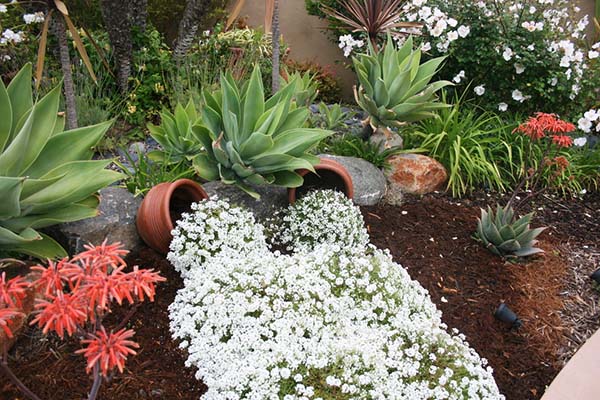
Content
Popular varieties and varieties of alyssum
There are not so many varieties of alyssum, most often in our gardens you can see the following:
- Rocky (Gold placer, Wave);
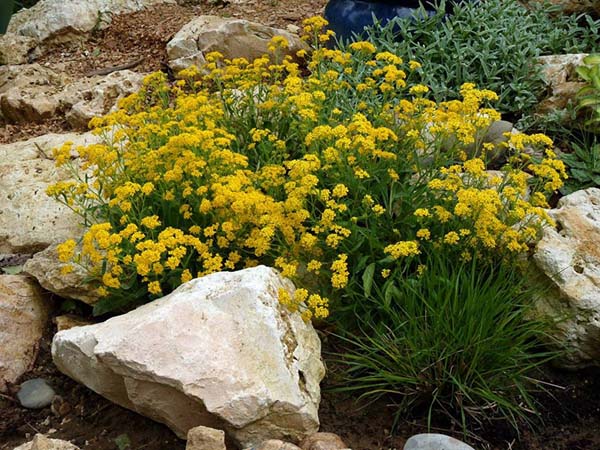
- Marine (Purple Haze, Purple Queen, Bentama, Transparent Crystal).
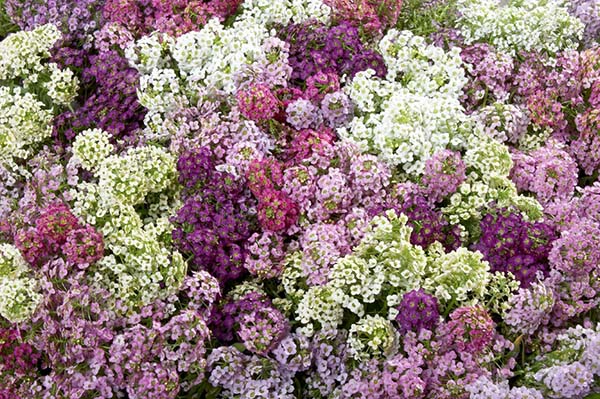
Growing alyssum through seedlings: when and how to sow
If you want to achieve an earlier flowering, then it is optimal to first grow alissum seedlings from seeds at home.
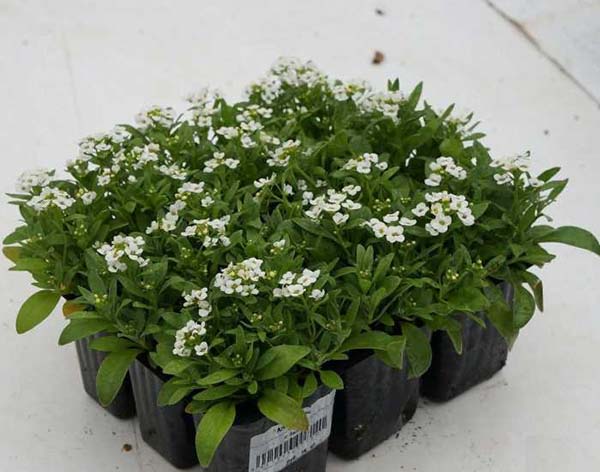
Sowing dates
The timing of planting alyssum for seedlings can vary depending on the climatic conditions of the region, as well as depending on the method of cultivation, for example, it can be grown with a double dive, when the plants are planted in open ground already abundantly flowering and quite mature. In this case, sowing is carried out already in march.
But, even if you have already missed these deadlines, then like most summer residents, plant the seeds of these beautiful flowers in April, and you will have a wonderful viable seedling.
Important! And here perennial It is advisable to plant alissum earlier than annual (lobularia), since it emerges worse and grows longer.
According to the lunar calendar in 2021
Choosing the optimal date for sowing seeds can help you Moon calendar.
Alyssum can be either an annual (annual) or a perennial plant, each of which has its own dates according to the lunar calendar.
We remind you! One-year alissum is a lobularia.
So favorable days for sowing one-year alissum (lobularia) in 2021 according to the lunar calendar are:
- in January - 27-29.
- in February - 1-8, 10-20, 25-29;
- in March - 2-8, 10-14, 29-31;
- in April - 1, 2, 5-7, 9, 17-20, 24, 25;
- in May - 2-6, 15-17, 20, 21, 25-31;
- in June - 2-4, 7-9, 11-14, 16-19.
Favorable days for sowing perennial alissum in 2021 according to the lunar calendar are:
- in January - 27-31;
- in February - 1-8, 10-20, 25-29;
- in March - 4-6, 12-14, 26-31;
- in April - 1, 2, 5-7, 9, 13-15, 24, 25;
- in May - 2-6, 15-17, 20, 21, 25-31;
- in June - 2-4, 6-9, 11-14, 23-25;
- in July - 6-11, 13-16, 23-29.
Important! Bad dates are the same for all cultures. These are the days of the Full Moon and New moons, as well as the period when the Moon is in Aquarius, because it is a barren and dry sign - italicized.
Unfavorable days according to the lunar calendar for 2021 for sowing alyssum are the following dates:
- in February -10-11, 27;
- in March -9-10, 13, 28;
- in April -5-6, 12, 27;
- in May -2-4, 11, 26, 30-31;
- in June -10, 24, 26-27.
Container and soil
The size of the planting container depends on how much seedlings you want to receive. Therefore, you can use both crates and a small plastic container (food container).
The soil for growing alissum should be light, loose, moisture and breathable. The soil mixture for filling the planting container can be prepared from peat, humus, black soil and sand, taken in equal proportions, and also adding the same amount of purchased substrate for planting flower seedlings.
Direct sowing
Step-by-step instructions for planting alissum seeds for seedlings:
- Prepare the container and soil.
- Fill the planting container with soil mixture.
- Make small grooves 3-4 centimeters apart.
- Carefully spread the lobularia seeds into the prepared grooves at a distance of 1-1.5 centimeters from each other.
- Sprinkle the seeds lightly with sand (about 0.5 centimeters). Or, just sow the seeds superficially (but do not thicken them too much, so that later they can be dived normally), and then lightly cover them with sand.
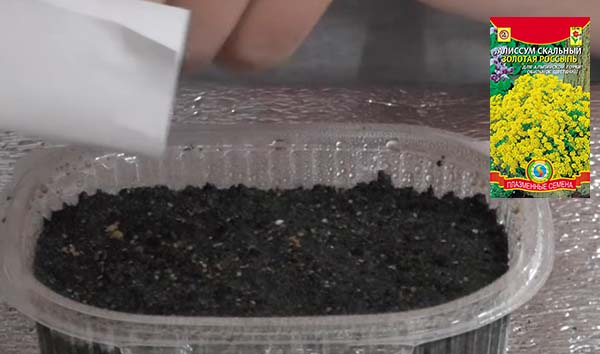
- Pour thoroughly with a spray bottle.
- Cover the planting container with transparent wrap, glass, a lid, or similar cover to create a greenhouse effect.
- Place the container with crops in a bright and warm place (+ 22-25 degrees).
Seedling care after sowing
As soon as the first friendly shoots appear (usually it takes a week), the shelter must be removed.
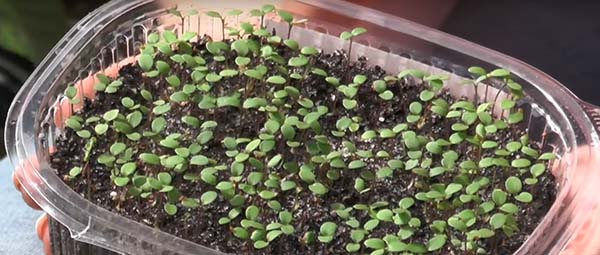
Now the seedlings can be rearranged to a relatively cooler place (+ 18-20 degrees). During the first week, round-the-clock illumination of young plant shoots is highly recommended.
Watering should be done in moderation, and in no case should the soil be allowed to dry out.
Picking
The appearance of 2-3 true leaves is a signal that the moment has come for picking up alyssum (as a rule, this happens 2-3 weeks after sowing).
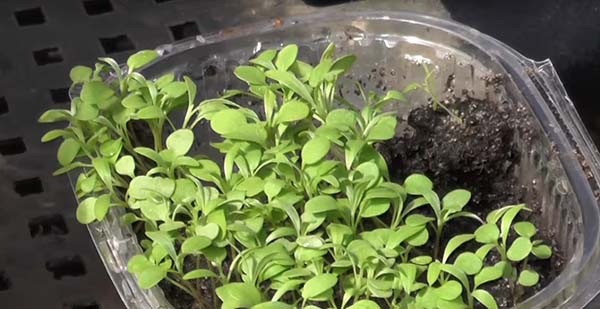
Picking alyssum seedlings can be done as follows: an hour before the procedure, spill the seedlings abundantly with water, then use tweezers to carefully remove several young plants along with the ground. Carefully separate them and bury them in a new common planting container at a distance of 2-3 centimeters, while the distance between the rows should be about 4-5 centimeters. Or use individual containers such as cups.
By the way! If you have a lot of seedlings, then in one glass you can dive 2 plants.
Further, after a couple of days, it is advisable to feed the transplanted seedlings of lobularia with complex mineral fertilizer (nitroammophos), dissolving 20-30 grams in 1 bucket of water.
Video: Alyssum's pick
Re-pick
If you decide to grow a lot of seedlings of these wonderful flowers, then you will need a second alyssum pick from common boxes into separate stanches.
Important! You can do without re-picking if you immediately pick the young seedlings into separate containers.
Video: the difference between growing alissum with one and two picks
The procedure for re-picking is more complicated, the plants are already old enough and damage to their roots cannot be allowed. Therefore, in advance (about an hour), sprinkle the seedlings well with water so that the plants are easier to reach. Then make enough indentations in the cups, very carefully remove the seedlings and transfer them to new individual dwellings, and then water.
After you finish the picking procedure, the transplanted alissum seedlings should be fed with a complex mineral fertilizer with a high phosphorus content (for example, superphosphate).
What to do if the seedlings have outgrown, and it is too early to plant them in open ground
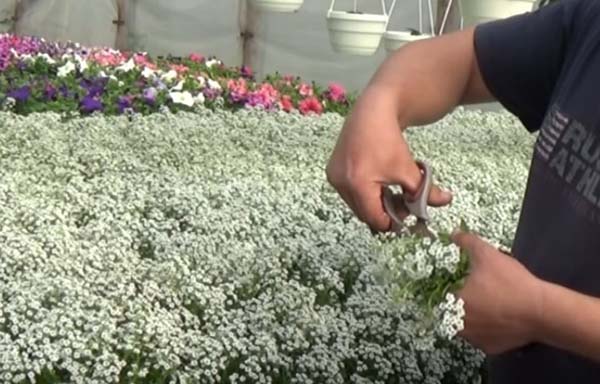
If you planted alyssum early enough, it began to outgrow and stretch (there is not enough space in the cup and blooms too abundantly), but while there is no opportunity for planting seedlings in open ground due to low temperature, the bush needs to be cut about half along with the flowers, and also remove all yellow leaves.
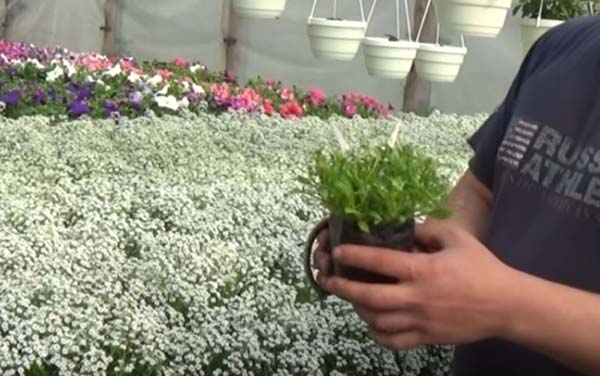
Planting seedlings in open ground
Approximately 4 weeks after the pick, the timing for planting alyssum seedlings in open ground is suitable. By this time, it will already begin to bloom and give off a delicious honey scent.
By the way! As for the place in the garden for planting a plant, it is described in more detail in the sub-item "Planting site" in the chapter on planting alissum directly into open ground.
Before planting seedlings in open ground, containers or cups with plants must be shed abundantly so that the flowers can be easily removed from the containers. Next, carefully remove them and place them in a pre-made landing hole.
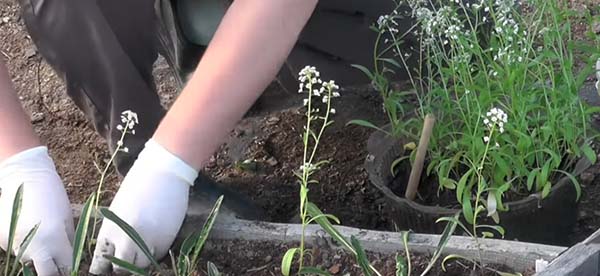
The last stage of planting is mulching for better moisture retention, as well as watering.
Video: growing alissum from seeds - planting seedlings and care
Planting alyssum seeds directly into open ground
Alyssum is quite cold-resistant, so it can be sown directly into the ground if you do not have enough space at home to grow it through seedlings.
Landing dates
Despite the fact that alyssum tolerates light frosts well, it is better to postpone sowing its seeds directly into open ground until a stable warm above-zero temperature, in other words, until the end of April - early May.
Remember! Flowering in this case will be a little late compared to growing through seedlings.
Some gardeners practice sowing alyssum in the fall before winter (in October-November). Thus, the seeds undergo natural stratification and subsequently give healthier and stronger shoots.
Landing place
It is optimal to find the sunniest place in the garden for this adorable flower, although a light partial shade is also suitable for it.
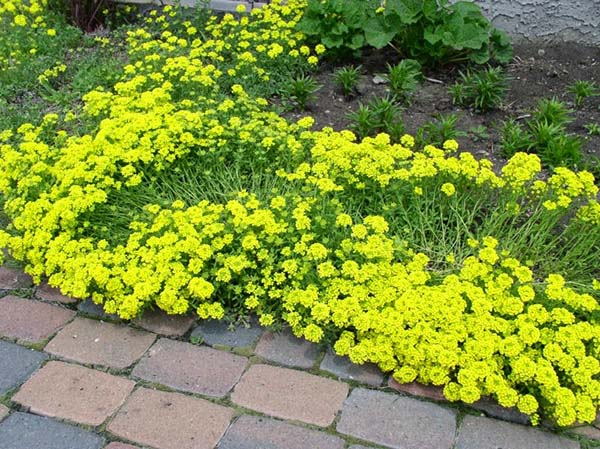
It grows well on all types of soils, but prefers lighter and more neutral reaction (acidity), and also does not like stagnant water.
Advice! It is advisable to add humus or compost to the ground in the fall or about a month before sowing.
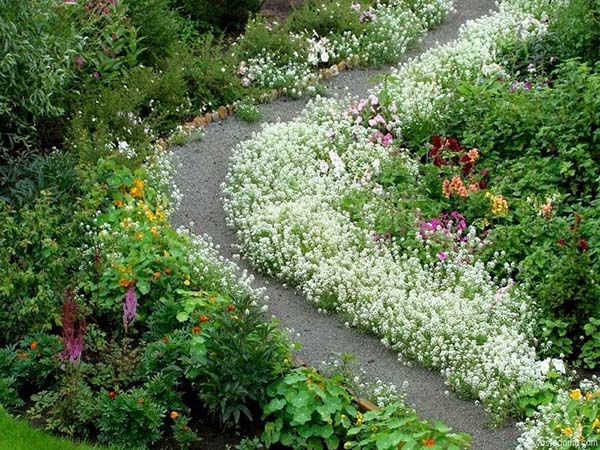
Planting alissum seeds in open ground does not differ much from sowing them for seedlings. It is not necessary to bury them strongly, it is enough to lightly sprinkle them with 0.5 centimeters of earth. If you want to get a tight, live border, then sow at a minimum distance from each other, this is about 3-4 centimeters.
Application in landscape design
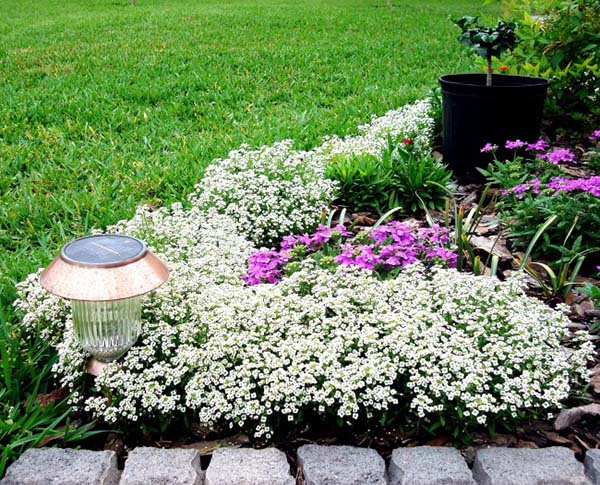
Alyssum (lobularia) is a magnificent curb groundcover, which will look great on all kinds of flower beds, beds. In addition, it is used to decorate an alpine slide or rockery, and is also grown in pots and balcony boxes. Thus, with the help of this wonderful plant, you can make very original flower arrangements.
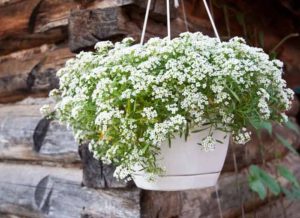
If you are thinking about joint plantings, then the combination of alyssum and petunias, gazania, purslane, marigolds, snapdragon and many other flowers and plants.
Video: petunia and alyssum
Alyssum is a flower that opens up really great if you use it correctly in the landscape design of your summer cottage.
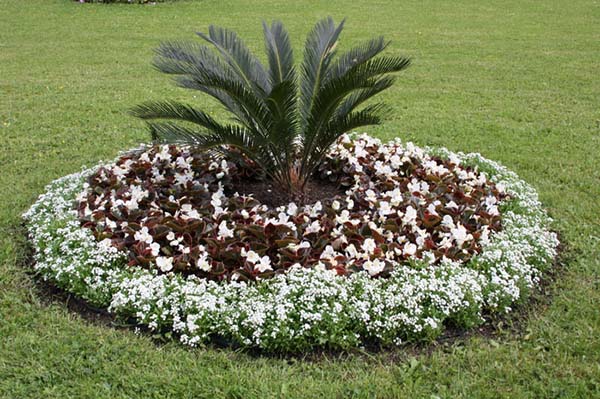
Outdoor care for alyssum
It is quite simple to care for alissum: as needed, at the beginning of its growth, it needs small weeding from weeds, loosening and watering.
Lobularia is very fond of and responds well to watering, therefore, in dry and hot summer weather, it needs fairly frequent and abundant moisture.
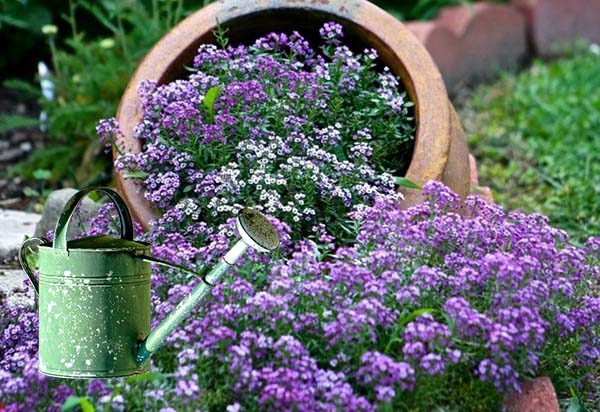
If you want to improve the flowering of the plant, then a couple of times a season it should be fed with a complex mineral fertilizer with a high content of potassium and phosphorus, but do not overdo it.
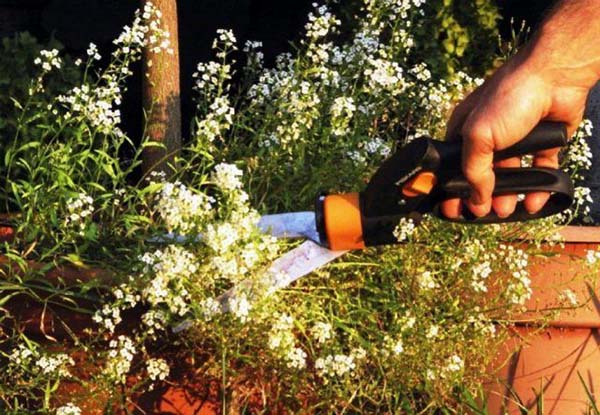
To prolong the flowering of alyssum, you should promptly remove the peduncles as they dry with scissors, otherwise the plant will spend extra energy on laying and forming seeds.
By the way! Annual alissum (lobularia) can bloom from May to October, so it is amongplants that bloom all summer.
The most dangerous pest
Alyssum belongs to the Cabbage family, which means that the plant can be completely mutilated. cruciferous flea... Therefore, during the germination period (if you planted it immediately in open ground), it should be covered with a thin spunbond and do not forget to water abundantly.
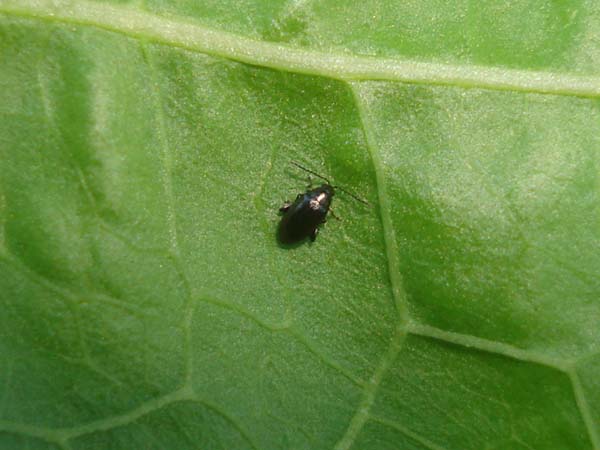
Also for the treatment and protection of alyssum from cruciferous flea you can use, for example, Karate Zeon, dust with tobacco dust and / or wood ash.
Thus, it is quite simple to grow alissum in the garden at your summer cottage. The plant is unpretentious and viable, it is easy to plant and care for them, so it is great for novice gardeners.
Video: alissum or lobularia

